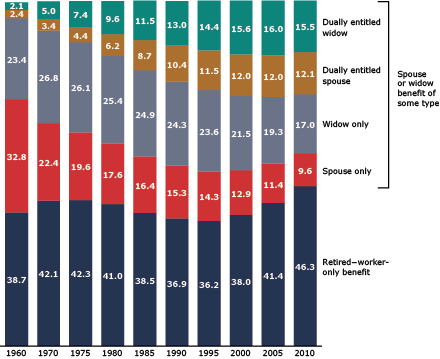Women's Eligibility Basis for Social Security Retirement Benefits Is Changing
September 2013The proportion of women aged 62 or older receiving a Social Security benefit based on their own earnings record is increasing
Dually entitled women increased from 5 percent in 1960 to 28 percent in 2010. Similarly, women receiving spouse-only benefits declined from 33 percent in 1960 to 10 percent in 2010, while those receiving only retired-worker benefits increased from 39 percent in 1960 to 46 percent in 2010.
A number of factors are associated with this increase, including:
- Increasing female labor force participation, particularly married women. 1
- Increasing proportions of women who never marry or divorce without a 10-year marriage.
Despite these changes, a majority of aged women still receive some type of Social Security spouse and survivor benefits
For example, including the dually entitled, in 1960 around 61 percent of women aged 62 or older received some type of spouse or survivor benefit compared with 54 percent in 2010.

| Year | Spouse or widow benefit of some type | Retired–worker-only benefit | |||
|---|---|---|---|---|---|
| Dually entitled widow | Dually entitled spouse | Widow only | Spouse only | ||
| 1960 | 2.1 | 2.4 | 23.4 | 32.8 | 38.7 |
| 1970 | 5.0 | 3.4 | 26.8 | 22.4 | 42.1 |
| 1975 | 7.4 | 4.4 | 26.1 | 19.6 | 42.3 |
| 1980 | 9.6 | 6.2 | 25.4 | 17.6 | 41.0 |
| 1985 | 11.5 | 8.7 | 24.9 | 16.4 | 38.5 |
| 1990 | 13.0 | 10.4 | 24.3 | 15.3 | 36.9 |
| 1995 | 14.4 | 11.5 | 23.6 | 14.3 | 36.2 |
| 2000 | 15.6 | 12.0 | 21.5 | 12.9 | 38.0 |
| 2005 | 16.0 | 12.0 | 19.3 | 11.4 | 41.4 |
| 2010 | 15.5 | 12.1 | 17.0 | 9.6 | 46.3 |
Background
- Ongoing changes in women's marriage and work patterns have implications for the type of Social Security benefits they receive.
- In addition to retired or disabled worker benefits, Social Security provides benefits to spouses or widow(er)s of insured workers.
- Eligibility for spousal or survivor benefits depends on a person's marital history and his or her life-time earnings relative to a current or previous spouse.
Key Terms
- Retired-worker beneficiaries qualify for retirement benefits based on their own work record.
- Spouse-only beneficiaries do not qualify for benefits based on their own work record, but qualify for up to 50 percent of their spouse's retired-worker benefit.
- Survivor-only beneficiaries do not qualify for benefits based on their own work record, but qualify for up to 100 percent of their deceased spouse's benefit.
- Dually entitled beneficiaries qualify for benefits based on their own work record and a spouse or survivor benefit based on their spouse's work record. Generally, the higher of the two benefits is paid.
1 Blau, Francine D., Marianne A. Ferber, and Anne E. Winkler. 2006. The Economics of Women, Men and Work. 5th ed. Englewood Cliffs, NJ: Prentice Hall.
SOURCE: All findings not otherwise referenced are from Iams, Howard M. and Christopher R. Tamborini. 2012. "The Implications of Marital History Change on Women's Eligibility for Social Security Wife and Widow Benefits, 1990–2009." Social Security Bulletin 72(2): 23–38.
NOTES: All content is simplified for presentation. Please see source material for full details and caveats.
The findings and conclusions presented in this summary are those of the authors and do not necessarily represent the views of the agency.